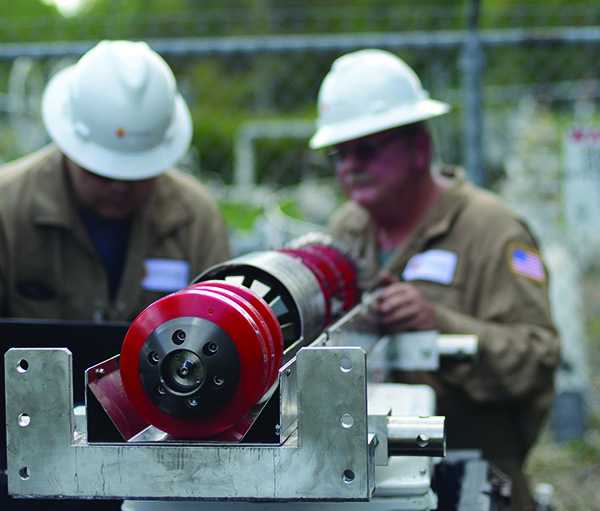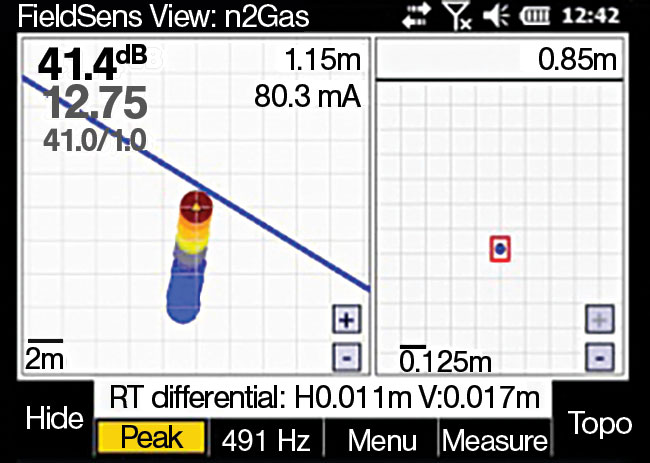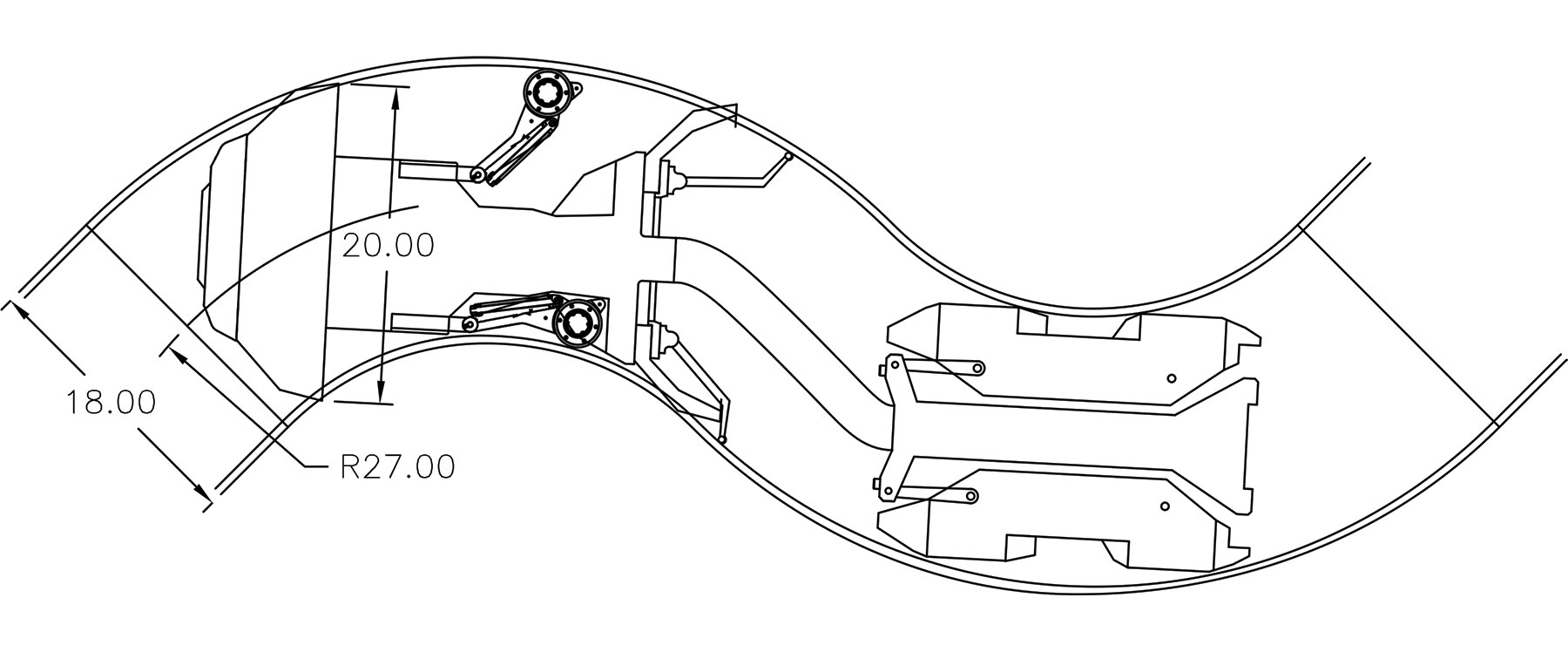August 2018, Vol. 245, No. 8
PPSA 2018 Pigging Update
In-Line Inspection of Low-Pressure, Low-Flow Gas Pipelines
By Mark Olson, President, Entegra, John Skinner, Lake Superior Consulting, and Brian Vandermark, President, Select Pipeline Services
Maintaining control of an In-Line Inspection (ILI) tool’s speed is one of the most critical elements in successfully assessing the condition of a pipeline. Success is defined as receiving an intact tool at the conclusion of the inspection and acquiring data of sufficient quality to achieve the vendor’s sizing and accuracy specifications.
An intact tool means not leaving any pig parts in the pipeline and minimizing damage to any of the tool’s sensing systems. Data quality must be sufficient for the ILI vendor to warrant that any reported pipeline features or anomalies are detected, characterized and sized within the specification of the ILI System, in accordance with the pipeline operator’s data quality specification, API 1163, and the Pipeline Operator’s Forum (POF) specification.
Tool speed can be challenging to manage both in large-diameter, high-speed gas pipelines and in small-diameter, low-pressure, low-flow gas pipelines, as well as off-line inspections with compressed air or Nitrogen. For almost two decades, speed control systems have been designed and deployed on ILI tools for high speed pipelines.
These systems might be a simple engineered solution allowing a fixed amount of bypass or they might be very complex, computer-actuated, active control valve arrangements that vary the amount of bypass in real time. But no such systems exist for low-pressure, low-flow situations. Therefore, the design of the tools and the operation of the pipelines become critical.
Regardless of the ILI system, only a surprisingly small amount of differential pressure is required to propel the tool, whether in a relatively steady state, straight line configuration or while navigating a restriction – a tight bend or heavy wall thickness, for example.
It is possible for a pipeline to operate with low pressure (under 400 psig in a 6-inch pipeline) but with sufficient flow to maintain speed within a desired range. Likewise, low flow with sufficient pressure is possible. But for various operational reasons, some pipelines are limited to both low-pressure and low-flow operating parameters.
In these low-pressure, low-flow conditions, speed excursions are the enemy of a successful pipeline inspection. The more extreme the speed excursions, the more severe the data degradation experienced, and the more tool damage that can be incurred. A few small speed excursions outside a tool’s operating parameters can usually be tolerated, as typically only a few feet of pipe end up being out of tolerance before the tool speed drops back down to the normal range.
However, some observed examples over the past 20 years include: 1) a 4-inch tool going from 0 mph to 75 mph back to 0 mph, four times before slamming into a 1.5-D bend and 2) a 6-inch tool going from 0 mph to 50-plus mph back to 0 mph in each pipe joint until stopping abruptly in the receiver. In both examples, the data was unusable and significant tool damage was incurred (primarily from trailing sections crashing into the back of the leading tool sections).
Speed excursions occur downstream of a local restriction in the pipeline. A typical restriction might be a tight bend, a significant wall thickness change (whether transitioned or un-transitioned), pipeline debris, or a heavy weld. Depending on the operating parameters, the ILI tool may hesitate momentarily, or it may come to a complete stop.
The pressure will then build up behind the tool until the differential pressure across the tool becomes great enough to allow the tool to start moving again. In this situation, the differential pressure is significantly higher than what is needed in the pipe immediately downstream of the restriction, and a speed excursion occurs.
The magnitude and duration of the speed excursion is dictated by how long it takes for the pressure ahead of the tool to pack up and for the flow to “catch up” to the tool. This settling action inside the pipe may cause several speed excursions before the pressure, flows and tool return to a more steady speed.
Tool Design
The two primary factors in tool design for low-pressure, low-flow applications are tow section sealing and overall tool drag.
First, the cups on the tow section must maintain seal at all times. If seal is lost, then gas will bypass the tool and it will stop. The only way to get the tool moving again is to significantly increase pressure and flow – a difficult if not impossible prospect for a pipeline that is already constrained to low-pressure, low-flow operations.
Careful consideration must go into the design of the tow section so that it can navigate the bends, full bore tees, and any other obstacles thought to exist in the pipeline; while minimizing the drag from the sealing surfaces. Design considerations include the distance between the cups, the diameter of the cups, and the hardness (durometer) of the polyurethane material in the cups.
Secondly, drag must be minimized by using wheeled suspension wherever possible. For magnetic flux leakage (MFL) ILI systems (axial or transverse field), the magnetic attraction of the magnetizer section of the tool is by far the overpowering cause of tool drag.
MFL tools are designed to maximize the effective magnetization of the pipe material (achieve inspection of the most wall thickness possible), while traversing the broadest range of pipeline features possible. Whether solid core or collapsible core (floating magnet) style, the magnetic strength (and wall thickness capability) is dictated by the volume (length, depth and thickness) of the iron backing material in the magnetic circuit. The overall length of the magnetizer is typically dictated by the desired bend radius capability of the system.
A 3-D bend tool can have a longer magnetizer section than a 1.5-D bend tool. The thickness of the backing material is dictated by the bore reduction capability of the tool. A tool designed to pass up to 25% bore restrictions will have less backing material than a tool designed to only pass a 10% bore restriction.
Most modern MFL systems are designed to pass 25% bore restrictions and back-to-back 1.5-D bends. Therefore, standard MFL systems will all have roughly the same magnetic strength and roughly the same magnetic drag. Special heavy wall MFL tools will have more magnetic strength and more magnetic drag – much more susceptible to speed excursions in low-pressure, low-flow applications.
Special low drag MFL tools exist, where wheels have been positioned on the ends of the magnetizer to hold the magnetizer off the pipe body. While effective at reducing drag, these tools can be significantly more expensive to use, and the maximum wall thickness capability can be greatly compromised due to the amount of backing material that must be removed to make room for the wheels and due to the standoff.
Operations
Before discussing pipeline operations, some terminology is needed:
The “launch” force is the differential pressure needed to move the tool from the oversize of the launcher into the nominal pipe. The break force is the force needed to get the tool moving. The towing force is the force required to overcome the tool drag after it is in motion.
A typical towing force for a standard axial MFL tool in straight 6-inch, standard wall thickness pipe might be less than 100 lbf, whereas the break force might be three or four times as much. The towing force would be expected to be much higher for this same 6-inch tool to navigate back-to-back 1.5-D bends or to traverse a section of heavy wall thickness pipe or a “heavy” weld.
The discharge pressure is the supply pressure, or the pressure at the upstream end of the pipeline. The back pressure is the pressure in front of the tool. The differential pressure is the pressure across the tow section of the ILI tool, or the pressure immediately upstream of the tool, less the pressure immediately downstream of the tool. A differential pressure of 10 psi would be expected to generate 289 pound force (lbf) of towing force in standard wall (0.280-inch w.t.), 6-inch pipe (differential pressure multiplied by the cross-sectional area of the pipe, 10 psi x 28.9 in2).
Liquid is an incompressible fluid, meaning that it can’t be compressed, and the density of the fluid is constant throughout the pipeline. Discounting elevation, the pressure at any location on a liquid pipeline is directly proportional to the flow in the pipeline.
On the other hand, gas is a compressible fluid and the pressure is related to how much gas can be squeezed into the available space (like a spring). In a low-pressure, low-flow liquid line, the ILI tool will simply travel slowly, but there will not be any speed excursions because the density of the fluid is the same in front and behind the tool. In a low-pressure, low-flow gas line, the situation is much more dynamic.
It is very difficult to control the speed of an ILI tool in a gas line by managing the discharge pressure and flow (i.e. controlling pressure and flow from behind the tool). While only a small differential pressure (less than 10 psi in the 6-inch case above) is required to move the tool in straight, nominal wall pipe, the tool may hesitate or stop at a restriction.
The pressure and flow will pack up behind the tool until there is sufficient differential pressure to move through the obstacle. When the tool returns to straight, nominal pipe, the local differential pressure will be much higher than necessary, and the tool can race forward until the pressure packs up in front of the tool and the flow “catches up” to the tool.
Ideally, when launching, one wishes to get the tool up to speed as quickly as possible, carrying enough momentum so that it doesn’t stop in a restriction. Start and stop operation is the most difficult situation for minimizing speed excursions. While not always practical, running in a liquid or gel “slug” can be effective in increasing the mass and significantly increasing the resistance to extreme acceleration or deceleration.
In general, the best operation involves controlling the pressure from in front of the tool and controlling the volume, or flow, from behind.
Assuming a steady gas supply, it is more effective to control the speed of an ILI tool from the downstream end of the pipeline – that is, from in front of the tool. Maintaining the line pack, or head pressure, in front of the tool will help minimize speed excursions and will better control the tool speed.
In low-pressure, low-flow pipelines, it is not unusual to start up against a closed valve. Initially the tool will move forward into the pipeline until the pressure in front of the tool begins to equalize. As the differential pressure approaches the minimum tow force to propel the tool, the downstream valve can be cracked open to keep the tool moving and then at least partially closed back down to maintain the desired speed. This process of opening the downstream valve and then pinching it back down can be repeated as necessary to maintain control of the tool speed. Generally, as the tool travels closer and closer to the end of the line, the downstream valve can be opened more and pinched less.
Volume is the key to keeping the tool moving. If a tool stops, the most common mistake is opening the downstream valve to bleed off pressure in front of the tool to “suck” the tool in. While this can get the tool moving, the problem is that the pressure differential will be too high when the flow catches up, and a speed excursion will likely occur. It’s best to maintain the line pack and wait for the flow to catch up.
In off-line operation, the volume can be increased by increasing the size of the inlet manifold – ideally up to the diameter of the nominal pipe – and increasing the number of high pressure, high volume air compressors or Nitrogen pumpers.
In practice, these operations are much more difficult than they sound. The amount of control provided is affected by the size of the inlet/outlet(s); the gearing on the downstream valve; the communication between all the operational personnel involved; the quantity, quality, resolution, and location of the pressure measurement devices; the operator’s knowledge of the pipeline systems physical characteristics; and other operational constraints.
Frequently, the most challenging aspect of the inspection is operating the downstream valve “on hand.” Consideration should be given to using a specialized back pressure control valve. With a computer-controlled valve on the downstream end of the pipeline, the desired differential pressure can be set, and the valve does all the work. If the tool stops at a restriction, the set point can be temporarily changed in small increments until the tools passes the restriction.
At the end of the day, speed excursions will always occur in low-pressure, low-flow pipelines. The objective is to do the best one can to minimize the magnitude and duration of the speed excursions. P&GJ
Authors: Mark Olson (BSME), President of Entegra, is a pipeline engineer with 27 years of pipeline design, construction, maintenance, operations, and integrity management experience. Mark was one of the original founders of Cornerstone Pipeline Inspection Group (CPIG) and the inventor of the MFL/Caliper combo tool. Later he managed the global pipeline inspection business unit for Baker Hughes. Most recently, Mark helped found the ultra-high resolution MFL/Caliper/IMU service company, Entegra.
John Skinner, Lake Superior Consulting, has almost 37 years’ experience running smart pigs in challenging pipelines around the world. Starting of as an ILI technician for TCPL/IPEL/IPEL-Kopp, John was the Operations Manager for Pipetronix and for CPIG. He also helped commercialize the CDI pipeline inspection tools. For the past 10 years, John has been consulting on challenging to inspect pigging operations around the world for Petersen Engineering and for Lake Superior Consulting.
Brian Vandermark is the Owner and President of Select Pipeline Services (SPS). SPS provides pipeline cleaning (mechanical and chemical), hydrotesting, drying, purging, and pipeline pigging (on-line and off-line) services primarily to northeastern gas distribution companies. The main expertise of SPS is to provide turnkey operational support for the pigging of low-pressure, low-flow gas distribution pipelines.









Comments